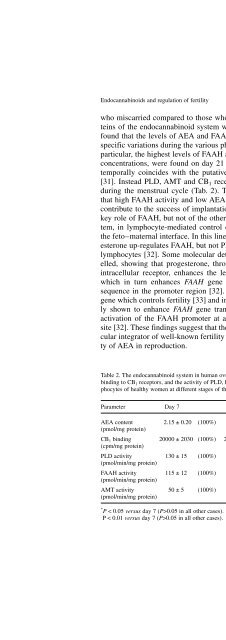3. Umbruch 4.4..2005 - Online Pot
3. Umbruch 4.4..2005 - Online Pot
3. Umbruch 4.4..2005 - Online Pot
You also want an ePaper? Increase the reach of your titles
YUMPU automatically turns print PDFs into web optimized ePapers that Google loves.
Endocannabinoids and regulation of fertility 73<br />
who miscarried compared to those who did not [30]. None of the other proteins<br />
of the endocannabinoid system were affected (Tab. 1). In addition, we<br />
found that the levels of AEA and FAAH in peripheral lymphocytes undergo<br />
specific variations during the various phases of the human ovulatory cycle. In<br />
particular, the highest levels of FAAH activity, paralleled by the lowest AEA<br />
concentrations, were found on day 21 of gestation, which is the period that<br />
temporally coincides with the putative window of implantation in humans<br />
[31]. Instead PLD, AMT and CB 1 receptors of lymphocytes did not change<br />
during the menstrual cycle (Tab. 2). This evidence strengthens the concept<br />
that high FAAH activity and low AEA levels may be among the factors that<br />
contribute to the success of implantation. Furthermore, they point towards a<br />
key role of FAAH, but not of the other proteins of the endocannabinoid system,<br />
in lymphocyte-mediated control of the hormone-cytokine networks at<br />
the feto–maternal interface. In this line, recent studies have shown that progesterone<br />
up-regulates FAAH, but not PLD, AMT or CB 1 receptors, in human<br />
lymphocytes [32]. Some molecular details of this activity have been unravelled,<br />
showing that progesterone, through formation of a complex with its<br />
intracellular receptor, enhances the level of the trancription factor Ikaros,<br />
which in turn enhances FAAH gene expression by binding to a specific<br />
sequence in the promoter region [32]. Also leptin, the product of the obese<br />
gene which controls fertility [33] and immune function [34], has been recently<br />
shown to enhance FAAH gene transcription through a STAT3-mediated<br />
activation of the FAAH promoter at a cAMP-response element (CRE)-like<br />
site [32]. These findings suggest that the hydrolase can be regarded as a molecular<br />
integrator of well-known fertility signals, and that it controls the activity<br />
of AEA in reproduction.<br />
Table 2. The endocannabinoid system in human ovulatory cycle. The endogenous levels of AEA, the<br />
binding to CB 1 receptors, and the activity of PLD, FAAH and AMT, were assayed in peripheral lymphocytes<br />
of healthy women at different stages of the menstrual cycle<br />
Parameter Day 7 Day 14 Day 21<br />
AEA content 2.15 ± 0.20 (100%) <strong>3.</strong>76 ± 0.35 (175%) *<br />
1.29 ± 0.14 (60%) *<br />
(pmol/mg protein)<br />
CB1 binding<br />
(cpm/mg protein)<br />
20000 ± 2030 (100%) 20000 ± 2050 (100%) 17400 ± 1795 (87%)<br />
PLD activity<br />
(pmol/min/mg protein)<br />
130 ± 15 (100%) 117 ± 12 (90%) 130 ± 15 (100%)<br />
FAAH activity<br />
(pmol/min/mg protein)<br />
115 ± 12 (100%) 46 ± 5 (40%) 253 ± 22 (220%)<br />
AMT activity<br />
(pmol/min/mg protein)<br />
50 ± 5 (100%) 43 ± 4 (86%) 45 ± 5 (90%)<br />
* P < 0.05 versus day 7 (P>0.05 in all other cases).<br />
P < 0.01 versus day 7 (P>0.05 in all other cases).







